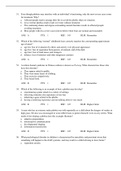Exam (elaborations)
University of Guelph| PSYCH 3390 Test Bank| Chapter 5: Anxiety Disorders| 50-100 and Essay| Complete Solutions
- Course
- Institution
University of Guelph| PSYCH 3390 Test Bank| Chapter 5: Anxiety Disorders| 50-100 and Essay| Complete Solutions
[Show more]



